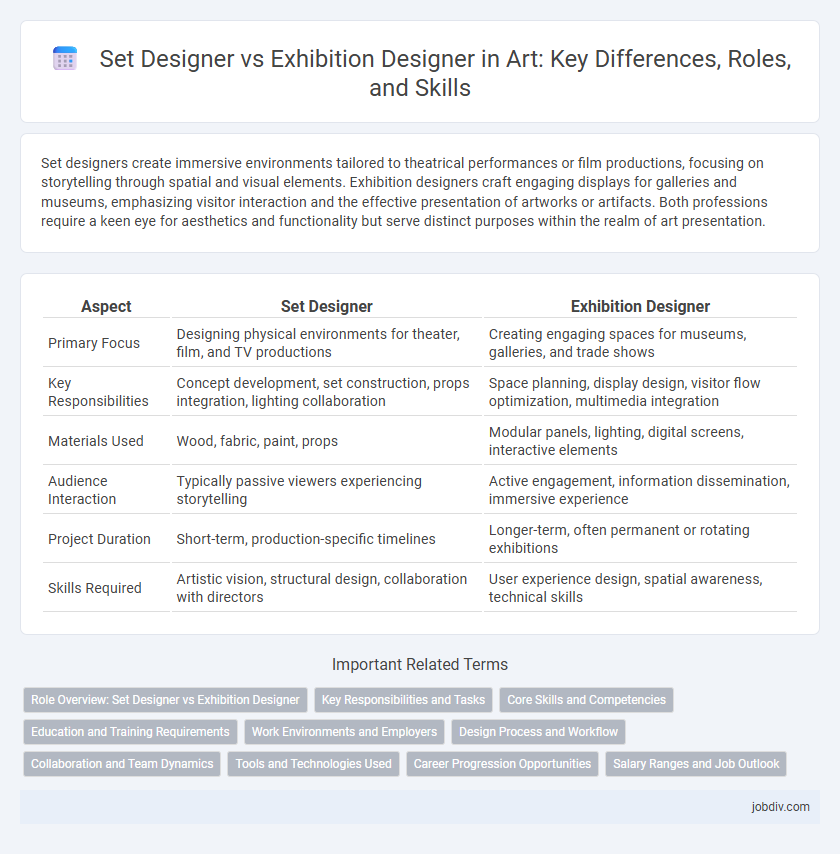Set designers create immersive environments tailored to theatrical performances or film productions, focusing on storytelling through spatial and visual elements. Exhibition designers craft engaging displays for galleries and museums, emphasizing visitor interaction and the effective presentation of artworks or artifacts. Both professions require a keen eye for aesthetics and functionality but serve distinct purposes within the realm of art presentation.
Table of Comparison
| Aspect | Set Designer | Exhibition Designer |
|---|---|---|
| Primary Focus | Designing physical environments for theater, film, and TV productions | Creating engaging spaces for museums, galleries, and trade shows |
| Key Responsibilities | Concept development, set construction, props integration, lighting collaboration | Space planning, display design, visitor flow optimization, multimedia integration |
| Materials Used | Wood, fabric, paint, props | Modular panels, lighting, digital screens, interactive elements |
| Audience Interaction | Typically passive viewers experiencing storytelling | Active engagement, information dissemination, immersive experience |
| Project Duration | Short-term, production-specific timelines | Longer-term, often permanent or rotating exhibitions |
| Skills Required | Artistic vision, structural design, collaboration with directors | User experience design, spatial awareness, technical skills |
Role Overview: Set Designer vs Exhibition Designer
Set designers create immersive environments for theater, film, and television, focusing on spatial dynamics, mood, and narrative support through physical structures and decor. Exhibition designers develop compelling layouts and displays for museums, galleries, and trade shows, emphasizing visitor experience, object presentation, and informational flow. Both roles require a sharp understanding of visual storytelling, materials, and audience engagement but differ in context and functional objectives.
Key Responsibilities and Tasks
Set designers create visually compelling environments for film, theater, or television productions, focusing on spatial layout, mood, and narrative support through props and scenery. Exhibition designers develop engaging displays for museums, galleries, or trade shows, emphasizing visitor flow, interaction, and effective communication of themes through multimedia and structural elements. Both roles require collaboration with directors or curators and a strong understanding of artistic principles and technical skills.
Core Skills and Competencies
Set designers excel in spatial visualization, lighting design, and prop integration to create immersive environments for theater and film productions. Exhibition designers specialize in curating visitor experiences through layout planning, interactive display design, and multimedia integration within museums or galleries. Both roles require strong creative problem-solving, technical drawing skills, and a deep understanding of materials, though set designers prioritize narrative storytelling while exhibition designers focus on educational engagement and audience flow.
Education and Training Requirements
Set designers typically require formal education in theater design, fine arts, or related fields, often earning a bachelor's degree with specialized training in stagecraft, lighting, and materials. Exhibition designers usually pursue degrees in graphic design, interior design, or museum studies, emphasizing spatial planning and visitor experience, supported by internships in galleries or museums. Both professions benefit from mastering digital design software, but set designers emphasize theatrical production techniques while exhibition designers focus on curatorial storytelling and audience engagement.
Work Environments and Employers
Set designers primarily work in theaters, film studios, and television production companies, creating immersive environments tailored to specific performances. Exhibition designers are commonly employed by museums, galleries, and trade show organizations, focusing on crafting engaging and informative displays for public viewing. Both professions often collaborate with artists, architects, and marketing teams, but their work environments differ significantly due to the nature of their projects and client needs.
Design Process and Workflow
Set designers focus on creating immersive environments tailored for live performances, emphasizing spatial dynamics, sightlines, and actor movement within theaters. Exhibition designers prioritize crafting interactive and informative displays in galleries or museums, integrating lighting, signage, and visitor flow to enhance user engagement. Both roles require collaboration with directors or curators, but set designers work within fixed timelines tied to production schedules, whereas exhibition designers often engage in extended planning phases aligned with thematic storytelling.
Collaboration and Team Dynamics
Set designers and exhibition designers collaborate closely to create immersive spatial experiences, blending theatrical storytelling with visual art display. Effective team dynamics rely on their shared expertise in spatial planning, material selection, and audience engagement strategies, ensuring cohesive environments. Their collaboration enhances artistic impact by integrating narrative elements and functional aesthetics seamlessly.
Tools and Technologies Used
Set designers utilize software like AutoCAD, SketchUp, and Vectorworks to create stage layouts and 3D models, often integrating traditional tools such as scale models and hand sketches. Exhibition designers rely on tools like Adobe Creative Suite, Rhino, and 3ds Max to develop visually immersive exhibits and interactive displays, utilizing digital fabrication technologies including CNC machining and 3D printing for precise construction. Both professions increasingly incorporate augmented reality (AR) and virtual reality (VR) technologies to visualize and refine designs before implementation.
Career Progression Opportunities
Set designers often advance by taking on larger productions, moving into film or television, and eventually leading creative teams as art directors or production designers. Exhibition designers can progress by managing high-profile museum installations, developing expertise in interactive or digital exhibits, and assuming roles like creative director or exhibition curator. Both careers benefit from expanding technical skills, portfolio diversity, and networking within the art and design industries.
Salary Ranges and Job Outlook
Set designers typically earn between $45,000 and $75,000 annually, with salaries influenced by production scale and location, while exhibition designers can expect a broader range from $40,000 to $85,000 depending on museum or gallery budgets and project scope. The job outlook for set designers is moderately competitive, heavily reliant on the entertainment industry's health, whereas exhibition designers benefit from steady demand due to ongoing growth in cultural institutions and experiential marketing. Both careers require strong design skills, but exhibition designers may experience more consistent employment opportunities in a wider variety of settings.
Set Designer vs Exhibition Designer Infographic

 jobdiv.com
jobdiv.com